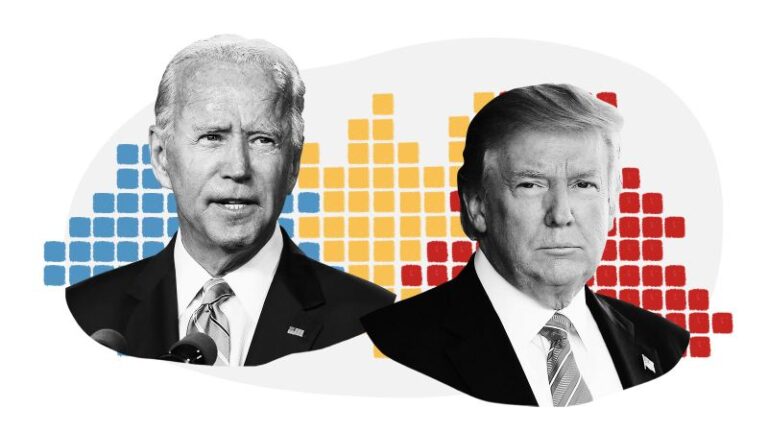View this interactive content on CNN.com
This story appears in CNN’s What Matters newsletter: Sign up for free to get it delivered to your inbox. here.
CNN
—
If you pay any attention to American politics, you’ve likely heard one version of this argument: The 2024 election to choose the president of a country of more than 330 million people will be decided by a small number of voters in a few key states.
There is concern, especially among Democrats, that President Joe Biden is losing support in these key states, and they are pressuring him to step aside and field another candidate.
But the assassination attempt on former President Donald Trump and questions about Biden’s fitness to serve another four years in office may not derail the broader race.
“I still think that the polls are not going to stray outside of a pretty narrow range in this race,” Republican pollster Kristen Soltis Anderson told CNN during its coverage of the Republican National Convention.
“If you liked Donald Trump last week, you’ll still like him this week. If you liked Joe Biden last week, you’ll still like him this week,” she said.
With that understanding in mind, consider just how small the margins were in the 2020 election: The states that Biden flipped from red to blue to beat then-President Trump did so with the support of a tiny fraction of voters in those states.
View this interactive content on CNN.com
If the two face off again in 2024, Trump will try to retake those same states from Democrat Joe Biden, who is seeking reelection to the White House in November, and the margin could be just as narrow.
But to say that a small minority of voters “decides” the election is a gross oversimplification of the American system and its evolution.
Here’s how it works:
There are 538 electoral college members. The votes are divided among the 50 states and the District of Columbia, with each state getting at least three votes depending on the size of its congressional delegation.
The least populous state has 3 electoral votes (2 senators and 1 representative). Washington DC also has 3. The most populous states have more electoral votes: California has 54 electoral votes (2 senators and 52 congressional districts). Texas has 40, Florida has 30, New York has 28, etc.
The winner is the candidate who receives at least 270 electoral votes. If no candidate receives at least 270 electoral votes, the House of Representatives chooses a winner from among the candidates who receive electoral votes.
Twelve states were decided by five percentage points or less in the 2016 or 2020 presidential elections. Maine is the only one of those states rated as favored by one party or the other in CNN’s 2024 election ratings, although one race within Maine is classified as close. Eleven other states are expected to be battlegrounds in the 2024 election. Ratings can be found here.
View this interactive content on CNN.com
Another way of looking at it is that states that were close in the last election can be expected to be close again in 2024. Polls back this up.
View this interactive content on CNN.com
In real numbers, the narrow margins in a relatively small number of states equate to a very small number of voters in a country of more than 330 million people. But both candidates need those two votes to reach the 270 electoral votes. Some of those states were decided by tens of thousands of votes. Biden led Democrats to win five states in 2020 – Arizona, Georgia, Pennsylvania, Michigan and Wisconsin – that Hillary Clinton lost, often by narrow margins, in 2016. Meanwhile, perennial battleground state Florida went in Trump’s favor in 2020.
View this interactive content on CNN.com
The campaign will attract more attention. They believe that less than a third of the total electoral votes are contestable or winnable by either party.
View this interactive content on CNN.com
Another thing to consider is that the constitutionally mandated decennial census reapportioned the number of electoral votes after the 2020 election. Potential battleground states North Carolina, Colorado and Florida each gained one electoral vote. Texas, which Democrats had long hoped would become a battleground but which continues to lean Republican despite demographic changes, also gained two electoral votes. Pennsylvania and Michigan were among the states that lost one vote.
This also means that the populations of these states are changing over time: 2024 battleground states could look very different in the future, and states that seem safe for either party today could become battlegrounds in the future.
Maine and Nebraska Electoral votes by district Instead of awarding all of a state’s electoral votes to the winner, for example in 2020 Biden won one vote in Nebraska and Trump won one vote in Maine. These individual electoral votes are That could be crucial if the election is close this year.
The final result will be in 2024. The election may again come down to a relatively small number of voters in a relatively small number of states.
View this interactive content on CNN.com
But the question remains: Who are those deciding voters? Is it the voter who reliably decides Republican or Democrat in most states in most elections? Is it the suburban woman turned off by Trump in 2020 or the college-educated voter who drifted to the Republican Party? Is it the older voter who leans Democratic or the younger voter who is showing interest in the Republican Party? Is it the indifferent voter who only occasionally votes, or is it a question of which party is more successful at getting its supporters to vote no matter what?
All of the above will be necessary for either candidate to win, although in some states the margins may be so small that gradual changes in the preferences or turnout of larger groups of voters could be decisive.


